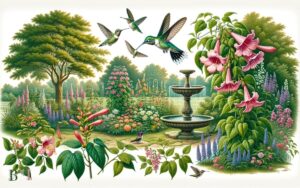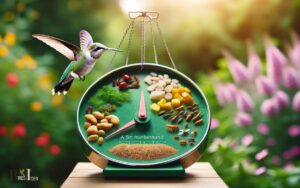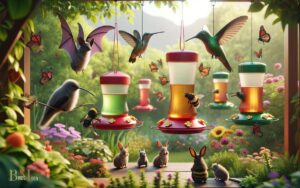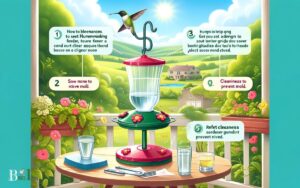Do Butterflies And Hummingbirds Eat The Same Food? Yes!
Yes, butterflies and hummingbirds often eat the same food, primarily nectar from flowers.
Both species are attracted to brightly colored blooms and rely on nectar as a key energy source. Butterflies and hummingbirds are nectarivorous, meaning they feed on nectar.
Here’s a closer look at their diets:
- Nectar: The primary food source for both. It provides the high-energy sugars needed for their active lifestyles.
- Flower Preference: They generally prefer tubular flowers for their nectar. However, their choices may vary based on accessibility and competition.
- Additional Foods:
- Butterflies: May also feed on pollen, tree sap, rotting fruit, and in some cases, animal dung or urine for additional nutrients.
- Hummingbirds: Occasionally eat insects and spiders for protein.
Butterflies and hummingbirds share a mutual affinity for nectar, sustaining their energy for flight and pollination activities.

Key Takeaway
The Role of Nectar in Their Diets
Both butterflies and hummingbirds rely on the consumption of nectar as a primary source of nutrition in their diets.
Nectar provides these creatures with the essential carbohydrates they need for energy. The high sugar content in nectar fuels their active lifestyles, enabling them to sustain their rapid flight patterns.
Nectar serves as a source of hydration for these small animals, especially in arid environments.
As both butterflies and hummingbirds visit flowers to feed on nectar, they inadvertently facilitate pollination, thereby contributing to the reproductive success of numerous plant species.
However, while nectar forms a fundamental part of their diets, the nutritional requirements of butterflies and hummingbirds differ in various aspects, leading to distinct dietary preferences and feeding behaviors.
This leads us to explore the subsequent section about their ‘varied nutritional needs’.
Varied Nutritional Needs
The nutritional requirements of butterflies and hummingbirds differ significantly, leading to distinct dietary preferences and feeding behaviors.
These differences are crucial to understand, as they directly impact the survival and well-being of these delicate creatures.
- Butterflies primarily feed on nectar, which provides them with the necessary sugars for energy.
- Hummingbirds, on the other hand, require a more complex diet that includes nectar for energy, as well as insects and spiders for protein and other essential nutrients.
- Butterflies have a longer digestive system designed to extract nutrients from liquid food, while hummingbirds have a specialized digestive system to process both nectar and insects.
- The varying nutritional needs also influence their foraging habits, with butterflies preferring stationary flowers and hummingbirds being able to hover and extract nectar from a wider range of floral species.
Understanding these distinct nutritional requirements is vital for creating environments that support the health and vitality of both butterflies and hummingbirds.
Plant Preferences and Foraging Habits
In understanding the dietary habits of butterflies and hummingbirds, it is essential to examine their plant preferences and foraging habits.
Butterflies often rely on nectar sources from a diverse range of flowering plants, with specific preferences for certain flower shapes, colors, and nectar compositions.
In contrast, hummingbirds exhibit distinct foraging behaviors, such as hover-feeding and trap-lining, and are particularly attracted to red or orange tubular flowers with high energy nectar.
This interplay between their plant preferences and foraging habits underscores the intricate ecological relationships between these pollinators and the plant species they depend on for sustenance.
Butterfly Nectar Sources
Nectar sources for butterflies encompass a diverse array of plant preferences and foraging habits.
Butterflies exhibit distinct preferences for specific nectar sources, often favoring certain plant characteristics and foraging patterns.
Some common nectar sources for butterflies include:
- Milkweed (Asclepias): Known for its rich nectar content and attractiveness to a wide variety of butterfly species.
- Lantana (Lantana camara): Notable for its vibrant colors and long-blooming period, making it a popular nectar source for butterflies.
- Buddleia (Butterfly Bush): Renowned for its sweet-smelling flowers, which are highly attractive to butterflies.
- Coneflowers (Echinacea): Recognized for their sturdy, daisy-like blooms that provide abundant nectar for butterflies.
Understanding the specific plant preferences and foraging habits of butterflies is crucial for creating butterfly-friendly habitats and promoting their conservation efforts.
Hummingbird Foraging Behavior
Hummingbirds exhibit distinct plant preferences and foraging habits, which play a crucial role in their ecological interactions.
These tiny birds are particularly attracted to brightly colored, tubular flowers such as trumpet vine, bee balm, and red salvia.
They also show a preference for nectar-rich blooms, including those of the coral honeysuckle and cardinal flower.
Their foraging habits involve hovering in front of flowers and using their long, specialized bills and extendable, tube-like tongues to extract nectar.
Hummingbirds are known to be highly territorial around productive food sources, often defending prime feeding areas from other hummingbirds and even larger birds.
They have been observed visiting a wide variety of plant species, showing flexibility in their foraging behavior to adapt to available food sources.
Understanding these preferences and habits is essential for creating habitats that serve the needs of hummingbirds.
Plant Diversity Impacts
The diversity of plants in a habitat directly influences the foraging habits and plant preferences of butterflies and hummingbirds.
This impact can be observed through the following:
- Specialization: Some butterfly species have specific host plant preferences for laying eggs, while certain hummingbird species show a preference for nectar from particular flower species.
- Seasonal Variations: Butterflies and hummingbirds may alter their foraging habits in response to seasonal changes in plant availability, with some plants flowering at specific times of the year.
- Niche Partitioning: Different species of butterflies and hummingbirds may exhibit niche partitioning, where they prefer distinct plant species, reducing competition for resources.
- Adaptations and Coevolution: The morphology and behavior of butterflies and hummingbirds can be adapted to efficiently extract nectar from specific flower shapes and structures.
Understanding these plant preferences and foraging habits is crucial for maintaining and conserving diverse plant communities.
These insights also have significant implications for the impact of feeding behaviors on pollination.
Impact of Feeding Behaviors on Pollination
Feeding behaviors significantly influence the pollination process, shaping the ecological interactions between butterflies and hummingbirds.
Butterflies tend to feed on nectar from a variety of flowers, and in doing so, they inadvertently transfer pollen from one flower to another, facilitating cross-pollination.
Hummingbirds, on the other hand, have long, slender bills that allow them to access nectar deep within flowers.
As they feed, their heads come into contact with the reproductive parts of the flower, leading to pollen transfer.
The impact of these feeding behaviors on pollination is evident in the table below, which highlights the differences in feeding mechanisms and their respective effects on pollination.
| Feeding Behavior | Butterfly Pollination | Hummingbird Pollination |
|---|---|---|
| Nectar Source | Wide variety of plants | Deep-throated flowers |
| Pollen Transfer | Moderate | High |
| Visitation Frequency | High | Moderate |
Understanding these feeding behaviors is crucial for conservation efforts and promoting the mutualistic relationship between pollinators and plants.
Seasonal Changes in Food Sources
Seasonal changes in food sources significantly impact the foraging habits of both butterflies and hummingbirds, influencing their pollination activities and ecological roles.
This phenomenon is crucial for understanding the dynamics of their interactions with plant species and their contributions to ecosystem health.
Some key observations include:
- Butterflies rely on nectar from a variety of flowers throughout the spring and summer months.
- Hummingbirds feed on nectar from specific flowering plants that bloom during their breeding season.
- Both species may switch to alternative food sources such as fruit juices, sap, or even small insects during periods of flower scarcity.
- The availability of certain plants during different seasons can influence the distribution and abundance of butterflies and hummingbirds in specific habitats.
Understanding these seasonal variations in food sources is essential for conservation efforts and sustainable management of natural environments.
Do Butterflies and Orioles Eat the Same Food?
Butterflies and orioles have distinct preferences when it comes to their diets. While butterflies usually feed on nectar-rich flowers, orioles are more inclined towards a combination of fruits, insects, and nectar. These hummingbird and oriole food differences highlight the diverse choices these beautiful creatures make, allowing them to thrive in their own unique ways.
Other Dietary Considerations
Butterflies and hummingbirds have dietary considerations that extend beyond nectar and flowers, encompassing a range of other food sources crucial to their nutritional needs.
In addition to nectar, butterflies also require minerals and salts, which they often obtain from damp soil, animal droppings, and decaying organic matter.
These alternative food sources provide essential nutrients such as sodium and amino acids, which are not present in nectar.
Hummingbirds, on the other hand, supplement their nectar-based diet with insects and spiders, particularly during the breeding season when they require a higher intake of protein for egg production and feeding their young.
Insects provide crucial nutrients such as protein, fats, vitamins, and minerals that are essential for the hummingbirds’ overall health and reproductive success.
Understanding these other dietary considerations is vital for supporting the diverse nutritional needs of butterflies and hummingbirds.
Conclusion
While butterflies and hummingbirds both feed on nectar, their nutritional needs, plant preferences, and foraging habits differ significantly.
The impact of their feeding behaviors on pollination and the seasonal changes in food sources further highlight the complexity of their diets. Despite conservation efforts, the availability of food for these pollinators remains a concern.
It is crucial to recognize the importance of maintaining diverse and abundant food sources to support the survival of these vital pollinators.






